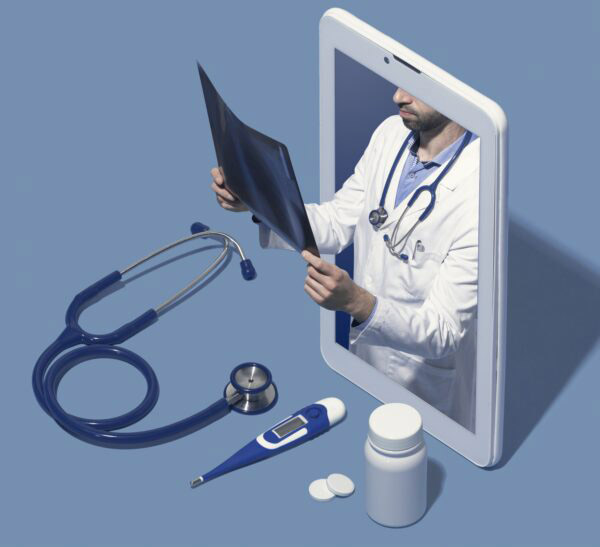
Internet has transformed today’s modern life. There are many telehealth tools accessible to help manage your health care and receive the services you need.
No one likes to visit hospitals, medical center. No one likes to wait and sit in a room surrounded by sick people or using car or public transit when one is feeling sick. This is true when sickness or condition can be easily identified, diagnosed and treatment can be given by having a conversation with a healthcare provider using technology.
There is a growing demand and popularity for Telehealth in the United States as it is very convenient, cost-effective, and it keeps patients safely away from each other which is highly important and necessary for protecting public health during the coronavirus pandemic.
What is Telehealth-
Telehealth is the use of electronic digital information and telecommunications technologies to get support of long-distance for health care, health-related education, public health and health related information services using computers or mobile devices. Live video conferencing, mobile health apps, “store and forward” electronic transmission, and remote patient monitoring (RPM) are examples of technologies used in telehealth.
Telehealth helps people to get access and support needed by overcoming the hurdle of distance, time & mobility.


Telehealth can be used in a variety of settings
- At home, by individuals connecting with healthcare providers
- At schools, to connect with a healthcare provider for advice on care for an ill or injured student
- In hospitals, to consult with specialists in another city
- In seniors’ residences and care facilities, particularly ones locked down due to an outbreak like COVID-19, for medications, follow-ups, assessments, and therapy sessions
- For remote patient monitoring (RPM), which sends readings from devices used by the patient at home (such as a blood pressure monitor, a pulse oximeter, or a glucose monitor) to the medical team for monitoring. This allows providers to send messages back to the patient or to connect via video call. COVID-19 kits, including digital stethoscopes, are currently being developed for RPM.
Some healthcare providers will provide consultations by phone—particularly during the coronavirus outbreak—but video communication is more common.
FAQ’s
Health organizations such as the American Hospital Association (AHA) are advocating for the expansion of telehealth practices and for more telehealth services to be covered by insurance. Even before the COVID-19 crisis, the use of telehealth was on the rise. As the healthcare system continues to integrate virtual check-ins and telecommunications technology, patients can look forward to more health care services from the comfort of their own homes.
While telehealth has potential for better coordinated care, it also runs the risk of fragmenting health care. Fragmented care may lead to gaps in care, overuse of medical care, inappropriate use of medications, or unnecessary or overlapping care. Testing such as blood work and X-rays would also require an in-person appointment to be performed, though they can be ordered through telehealth.
- Accessibility. Many patients face barriers when it comes to in-person healthcare visits. Whether due to disabilities, physical distance/living in a rural area, or transportation difficulties, many patients are able to receive medical consultations via telehealth they may otherwise have missed.
- Cost efficiency. Patients save in transportation costs and travel time, along with overall healthcare costs thanks to better access to treatment.
- Faster availability of appointment times. Care is available whenever a patient has time, and a doctor has a slot. There are more options when you are not limited by location.
- Flexibility. Patients and providers do not need to communicate in real time. Photos of visible conditions such as rashes, data such as blood pressure readings, or patient questions can be sent to the provider at any time. The provider can review this health information, send questions or other materials to the patient, or send instructions ahead of the scheduled appointment time.
- Lowered exposure to infection. The patient is not exposed to others who may be contagious, like they would be in a clinic, and healthcare providers aren’t exposed to potentially infectious patients.
Healthcare professionals conducting telehealth visits will determine if further consultation, testing, or treatment is needed. This may include sending the patient for an in-person consultation with a healthcare provider, advising a patient to call 911 or to go to the hospital for emergency care, or ordering lab tests or imaging.
Like an in-office visit, the physician will review the medical chart. The doctor will ask medical questions and may request prior records or that additional lab testing be performed. The physician may write a prescription, which is then sent directly to a mail order pharmacy for home delivery or a local pharmacy for the patient to pick-up.”
Some telehealth technology requirements to consider include:
- A reliable device such as a smartphone, tablet, or laptop that enables audio/video
- A program, app, or website to connect with the care provider
- A good wired internet connection or strong wifi
- Headphones (not essential, but can be helpful with privacy and to block out noise)
How can a patient prepare for a telehealth appointment?
Before the appointment, find a private, quiet space with good lighting. Patients should also make sure they know what to do if they become disconnected from the care provider during the appointment. The care provider may call the patient if this happens, so it is important to ensure the provider has correct contact information for the patient. Have any information the care provider may need handy, such as recent lab results, imaging that has been done, etc. Patients should have a list of questions and concerns ready and be prepared to show the care provider anything that needs to be assessed visually, such as a rash.
Many insurance providers do offer telehealth coverage, and the number of services covered is increasing. Almost every state has at least some Medicaid telehealth services covered by the program, and Medicaid and Medicare have recently instituted regulations to encourage the use of telehealth during the coronavirus public health emergency.
Telehealth can also be used as a form of triage. If a patient isn’t sure whether an illness or injury requires a trip to an in-person healthcare provider, or even an emergency room, a telehealth consultation can determine severity and if further care is needed. If an in-person visit or emergency room trip is deemed necessary, the telehealth practitioner can call ahead to the ambulance, hospital, or in-person care provider with their primary assessment and information. In addition to improving the care of the patient, this is especially helpful during an outbreak like coronavirus to prepare medical staff for a potentially infectious patient.
While the terms are often used interchangeably, they refer to different practices. Telehealth is a broad term for health services rendered remotely using communication technology, not limited to medical consultations.
Telemedicine is a subset of telehealth that meets the requirements of clinical services (the practice of medicine between a patient and a healthcare provider). Essentially, telemedicine is like a visit to a healthcare provider, but virtually, usually via video-conferencing. Telemedicine providers are required to follow the same Health Insurance and Portability Act (HIPAA) responsibilities for virtual care as they are for in-person patient care.

